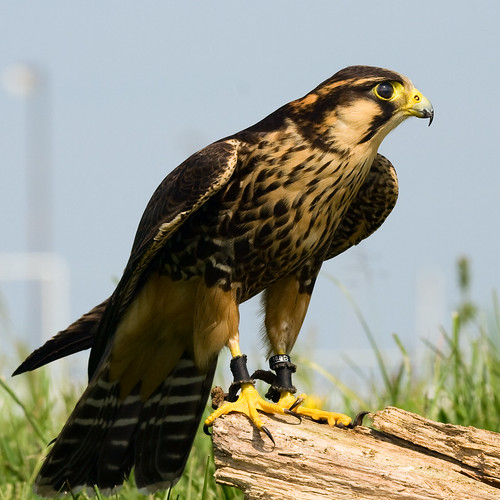Aplomado Falcon Biography







Falco fusco-caerulescens, Northern Aplomado Falcon (septentrionalis).
Nearctic/Neotropical. Southern UNITED STATES (Texas, New Mexico) south through portions of the CARIBBEAN slope of MEXICO and Central America and South America on both sides of the Andes to TIERRA DEL FUEGO; absent from most of Amazonia; accidental in Puerto Rico.
Subspecies: 3 races. F. f. septentrionalis: Southern UNITED STATES (Texas; formerly Arizona and New Mexico) south through MEXICO (Chihuahua, Oaxaca, and formerly Sinaloa) to GUATEMALA; F. f. femoralis: BELIZE, eastern HONDURAS and NICARAGUA (Mosquitia), and PANAMA to COLOMBIA east to the GUIANAS and south through eastern BOLIVIA and BRAZIL to ARGENTINA and URUGUAY south to TIERRA DEL FUEGO; TRINIDAD; F. f. pichinchae: Southwestern COLOMBIA, ECUADOR, PERU, and western BOLIVIA to northern CHILE (Arico to Curicó and northwestern ARGENTINA (Tucumá).
Taxonomy: This species was formerly called F. fusco-caerulescens (e.g., Hellmayr and Conover 1949), but see Peters and Griswold (1943) and Blake (1977) for the basis for the name change. It appears to be most closely related to F. rufigularis and F. deiroleucus (Bierregaard 1994).
Movements: Partial migrant and also an altitudinal migrant in some areas (Bildstein 2006). Northernmost and southernmost populations are probably migratory, although the extent of movements is largely undocumented. Sick (1993) noted that migratory flocks, presumably from more southern populations, are seen periodically in Brazil. The race pichinchae descends seasonally to the coast in Peru and in the south to Curico, Chile from breeding areas in the Andes (Fjeldså and Krabbe 1990). At least some Argentine populations appear to be resident (Contreras et al. 1990, Di Giacomo 2005), but birds breeding on Tierra del Fuego migrate north to the South American mainland in the austral winter (Humphrey et al. 2004).
Habitat and Habits: Throughout its range, it prefers open areas, including savannas, open woodland, pine savanna, and pastures with scattered trees. In the Andes, it is found in open country, ranging from savanna and bushland to rolling puna country or rugged mountains and is sometimes associated with Eucalyptus groves in the highlands (Fjeldså and Krabbe 1990). In austral South America, it even occurs in patches of open habitats in large cities. Occurs singly or in pairs, or sometimes in small migrant flocks (Sick 1993). Often unwary.
Food and Feeding Behavior: Feeds mainly on birds (mostly bird-sized or smaller), small mammals (including bats), snakes, lizards, large insects, and swarming termites. Birds may hunt from an exposed perch, stooping with half-closed wings, or pursue aerial prey singly or in pairs, flying low off the ground. Aplomados often seek prey flushed by grass fires or grazing large mammals, and they sometimes hover.
Breeding: Nests in an old raven or hawk nest, including some placed on power poles, and occasionally on the ground. Clutch size is 2-3 eggs, which have a white ground color and numerous brown spots and blotches, sometimes completely suffused over the surface of the shell. At Argentine nests, the incubation period averaged 32 days, and the nesting period varied from 33 to 37 days (Di Giacomo 2005)
Conservation: Widespread, occurring in a wide variety of habitats and altitudinal zones, but generally rare or uncommon in most areas. However, it may be expanding its range in some regions, e.g., parts of Mexico and Central America, in response to deforestation. Although aplomados experienced significant DDE-induced eggshell thinning in eastern Mexico in the 1960s-1970s (Kiff et al. 1980), the species evidently had almost disappeared from the United States portion of its breeding range by the 1940s, prior to the advent of synthetic pesticides. The reasons for the decline are not clear, but are possibly related to land use changes which resulted in a decrease in the savanna-like habitat preferred by this species. Although it is still retained on the U.S. Federal Endangered Species list, an ambitious captive breeding and reintroduction program by The Peregrine Fund, beginning in the mid-1990s, resulted in the establishment of a breeding population of about 40 pairs in South Texas, and additional reintroductions are currently being conducted in West Texas and New Mexico. Categorized as a species of "Least Concern" by BirdLife International.
Aplomado Falcon

Aplomado Falcon

Aplomado Falcon

Aplomado Falcon

Aplomado Falcon

Aplomado Falcon

Aplomado Falcon
 Aplomado Falcon
Aplomado Falcon

Aplomado Falcon
Aplomado VS Quail
Caza Con Halcon Aplomado
No comments:
Post a Comment